Global Energy Outlook: Trends, Policies, and Implications Essay
VerifiedAdded on 2020/04/29
|8
|2171
|127
Essay
AI Summary
This essay provides an in-depth analysis of the global energy outlook, examining the evolving trends and requirements within the energy sector. It explores the impact of climate change on energy production and consumption, highlighting the significance of the Paris Agreement and the shift towards renewable energy sources like wind and solar. The essay discusses the role of international organizations such as the International Energy Agency in promoting sustainable energy practices. It also analyzes the energy policies of various countries, including the United States under the Trump administration, Brazil, the European Union, Russia, China, and India, comparing their approaches to renewable energy adoption and climate change mitigation. The essay concludes that despite global efforts, some countries have not taken climate change seriously, which could have a negative impact on the world.
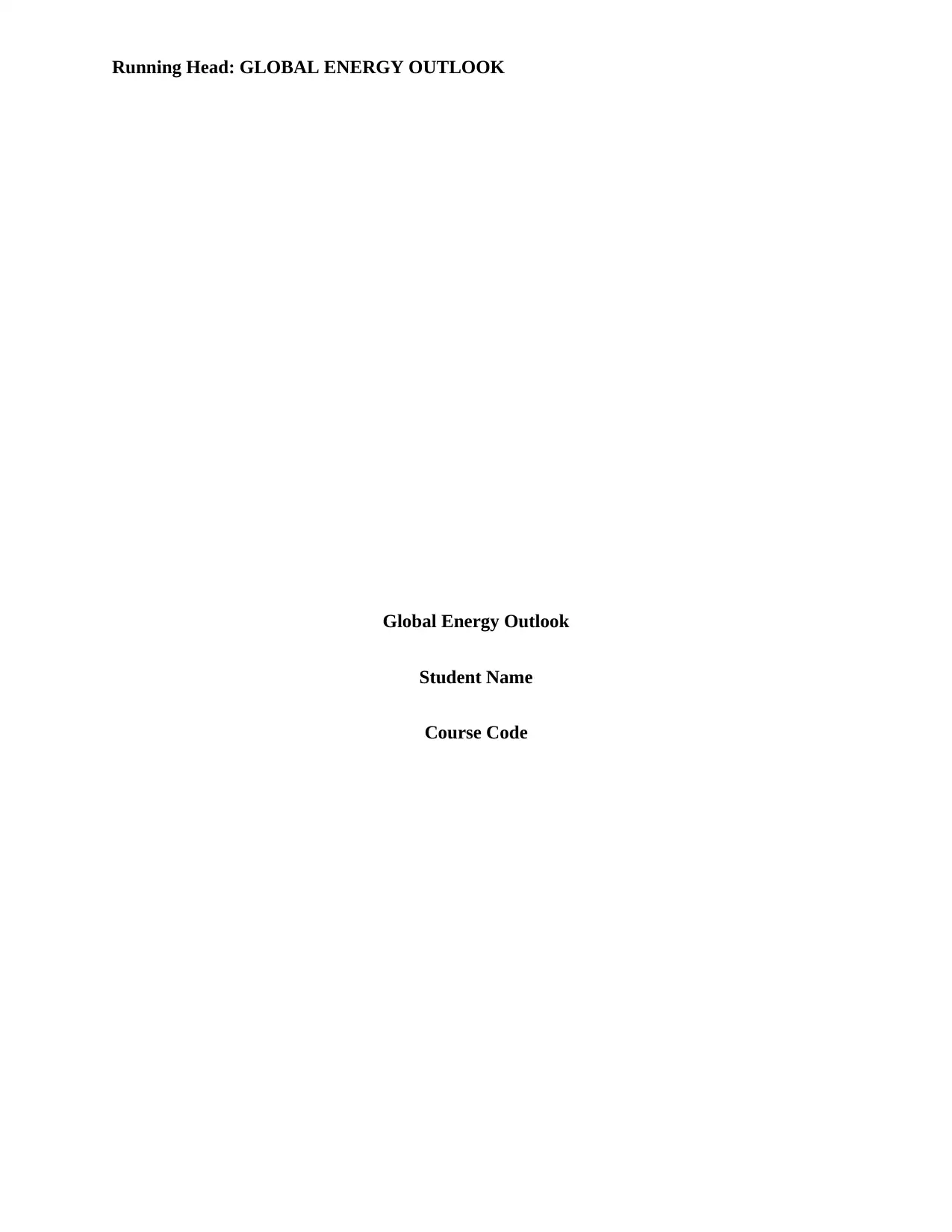
Running Head: GLOBAL ENERGY OUTLOOK
Global Energy Outlook
Student Name
Course Code
Global Energy Outlook
Student Name
Course Code
Paraphrase This Document
Need a fresh take? Get an instant paraphrase of this document with our AI Paraphraser
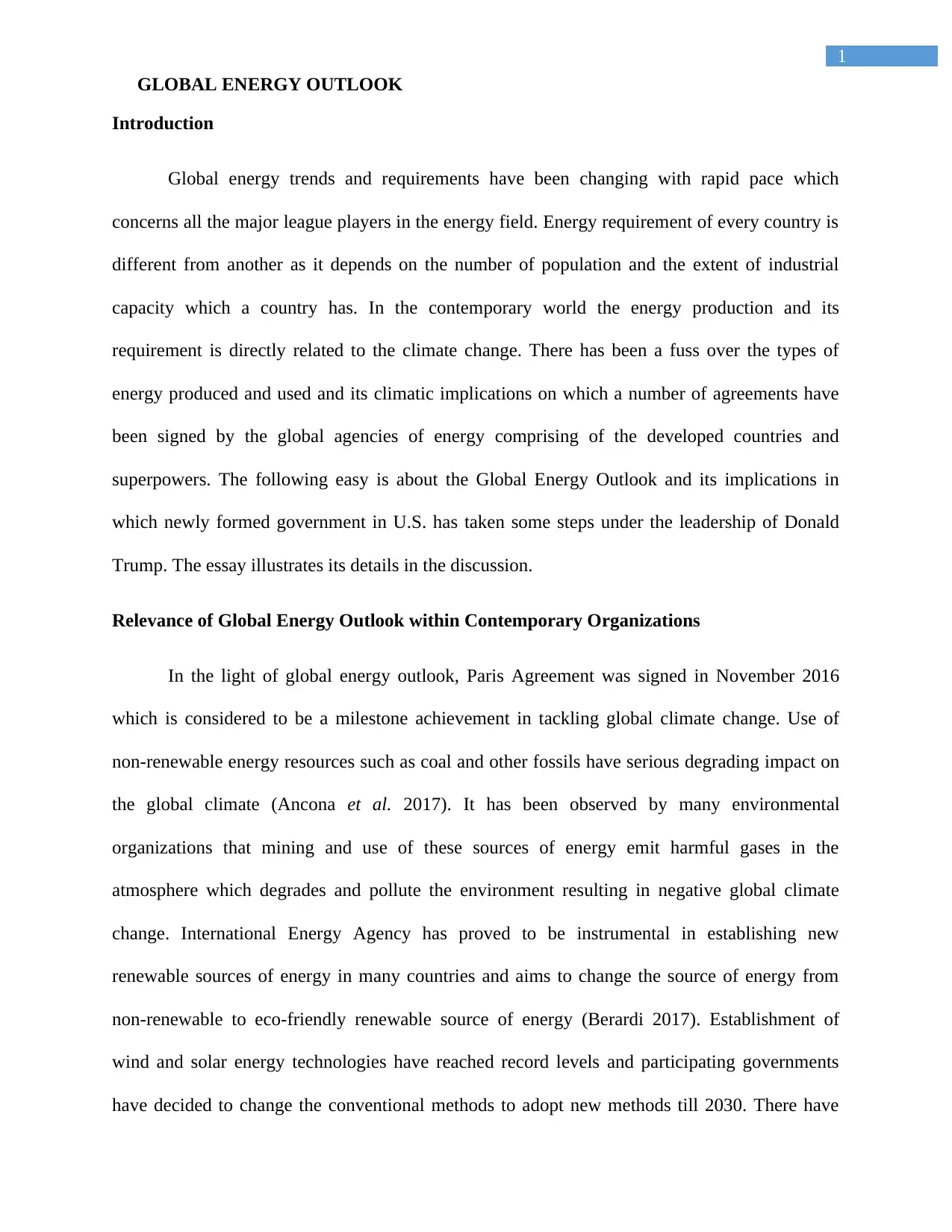
1
GLOBAL ENERGY OUTLOOK
Introduction
Global energy trends and requirements have been changing with rapid pace which
concerns all the major league players in the energy field. Energy requirement of every country is
different from another as it depends on the number of population and the extent of industrial
capacity which a country has. In the contemporary world the energy production and its
requirement is directly related to the climate change. There has been a fuss over the types of
energy produced and used and its climatic implications on which a number of agreements have
been signed by the global agencies of energy comprising of the developed countries and
superpowers. The following easy is about the Global Energy Outlook and its implications in
which newly formed government in U.S. has taken some steps under the leadership of Donald
Trump. The essay illustrates its details in the discussion.
Relevance of Global Energy Outlook within Contemporary Organizations
In the light of global energy outlook, Paris Agreement was signed in November 2016
which is considered to be a milestone achievement in tackling global climate change. Use of
non-renewable energy resources such as coal and other fossils have serious degrading impact on
the global climate (Ancona et al. 2017). It has been observed by many environmental
organizations that mining and use of these sources of energy emit harmful gases in the
atmosphere which degrades and pollute the environment resulting in negative global climate
change. International Energy Agency has proved to be instrumental in establishing new
renewable sources of energy in many countries and aims to change the source of energy from
non-renewable to eco-friendly renewable source of energy (Berardi 2017). Establishment of
wind and solar energy technologies have reached record levels and participating governments
have decided to change the conventional methods to adopt new methods till 2030. There have
GLOBAL ENERGY OUTLOOK
Introduction
Global energy trends and requirements have been changing with rapid pace which
concerns all the major league players in the energy field. Energy requirement of every country is
different from another as it depends on the number of population and the extent of industrial
capacity which a country has. In the contemporary world the energy production and its
requirement is directly related to the climate change. There has been a fuss over the types of
energy produced and used and its climatic implications on which a number of agreements have
been signed by the global agencies of energy comprising of the developed countries and
superpowers. The following easy is about the Global Energy Outlook and its implications in
which newly formed government in U.S. has taken some steps under the leadership of Donald
Trump. The essay illustrates its details in the discussion.
Relevance of Global Energy Outlook within Contemporary Organizations
In the light of global energy outlook, Paris Agreement was signed in November 2016
which is considered to be a milestone achievement in tackling global climate change. Use of
non-renewable energy resources such as coal and other fossils have serious degrading impact on
the global climate (Ancona et al. 2017). It has been observed by many environmental
organizations that mining and use of these sources of energy emit harmful gases in the
atmosphere which degrades and pollute the environment resulting in negative global climate
change. International Energy Agency has proved to be instrumental in establishing new
renewable sources of energy in many countries and aims to change the source of energy from
non-renewable to eco-friendly renewable source of energy (Berardi 2017). Establishment of
wind and solar energy technologies have reached record levels and participating governments
have decided to change the conventional methods to adopt new methods till 2030. There have
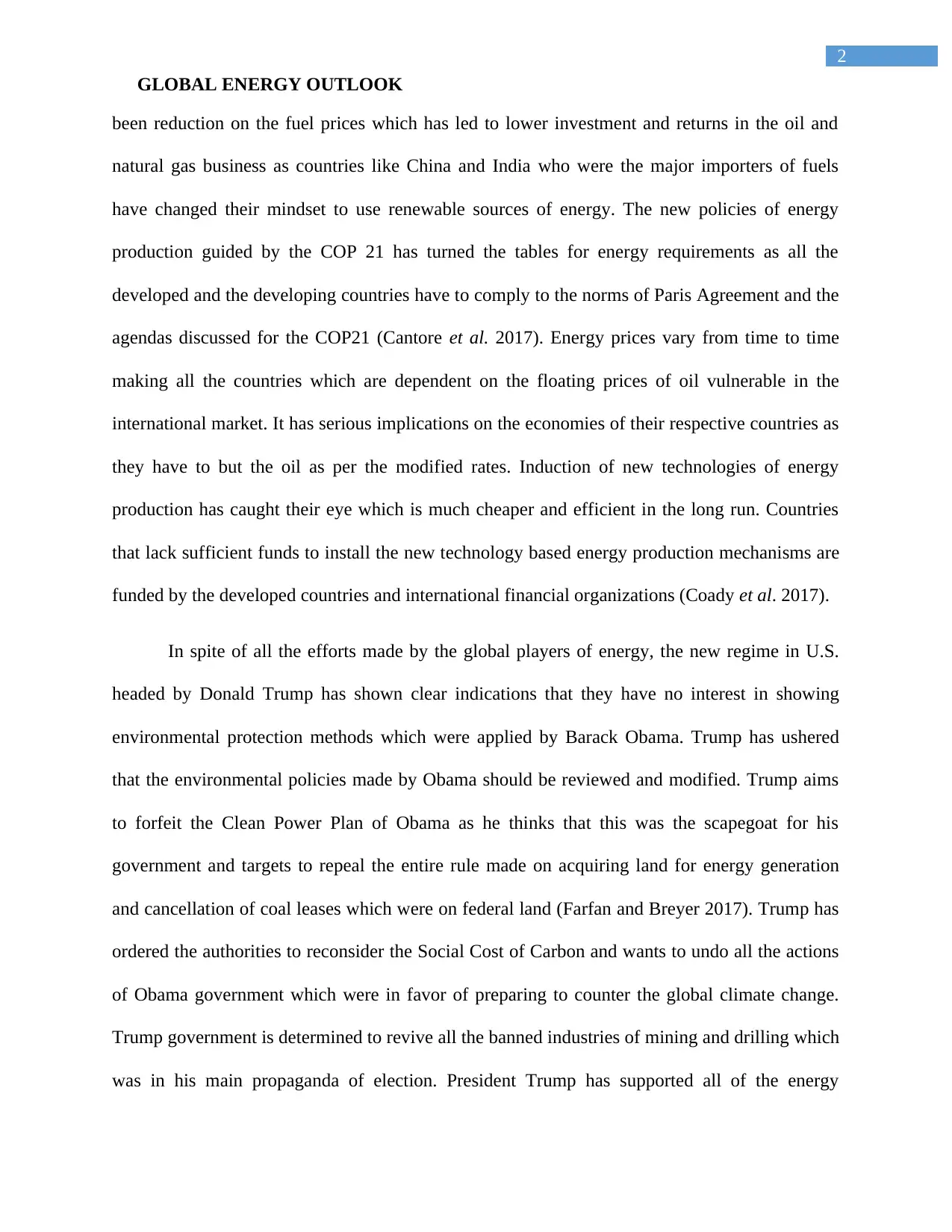
2
GLOBAL ENERGY OUTLOOK
been reduction on the fuel prices which has led to lower investment and returns in the oil and
natural gas business as countries like China and India who were the major importers of fuels
have changed their mindset to use renewable sources of energy. The new policies of energy
production guided by the COP 21 has turned the tables for energy requirements as all the
developed and the developing countries have to comply to the norms of Paris Agreement and the
agendas discussed for the COP21 (Cantore et al. 2017). Energy prices vary from time to time
making all the countries which are dependent on the floating prices of oil vulnerable in the
international market. It has serious implications on the economies of their respective countries as
they have to but the oil as per the modified rates. Induction of new technologies of energy
production has caught their eye which is much cheaper and efficient in the long run. Countries
that lack sufficient funds to install the new technology based energy production mechanisms are
funded by the developed countries and international financial organizations (Coady et al. 2017).
In spite of all the efforts made by the global players of energy, the new regime in U.S.
headed by Donald Trump has shown clear indications that they have no interest in showing
environmental protection methods which were applied by Barack Obama. Trump has ushered
that the environmental policies made by Obama should be reviewed and modified. Trump aims
to forfeit the Clean Power Plan of Obama as he thinks that this was the scapegoat for his
government and targets to repeal the entire rule made on acquiring land for energy generation
and cancellation of coal leases which were on federal land (Farfan and Breyer 2017). Trump has
ordered the authorities to reconsider the Social Cost of Carbon and wants to undo all the actions
of Obama government which were in favor of preparing to counter the global climate change.
Trump government is determined to revive all the banned industries of mining and drilling which
was in his main propaganda of election. President Trump has supported all of the energy
GLOBAL ENERGY OUTLOOK
been reduction on the fuel prices which has led to lower investment and returns in the oil and
natural gas business as countries like China and India who were the major importers of fuels
have changed their mindset to use renewable sources of energy. The new policies of energy
production guided by the COP 21 has turned the tables for energy requirements as all the
developed and the developing countries have to comply to the norms of Paris Agreement and the
agendas discussed for the COP21 (Cantore et al. 2017). Energy prices vary from time to time
making all the countries which are dependent on the floating prices of oil vulnerable in the
international market. It has serious implications on the economies of their respective countries as
they have to but the oil as per the modified rates. Induction of new technologies of energy
production has caught their eye which is much cheaper and efficient in the long run. Countries
that lack sufficient funds to install the new technology based energy production mechanisms are
funded by the developed countries and international financial organizations (Coady et al. 2017).
In spite of all the efforts made by the global players of energy, the new regime in U.S.
headed by Donald Trump has shown clear indications that they have no interest in showing
environmental protection methods which were applied by Barack Obama. Trump has ushered
that the environmental policies made by Obama should be reviewed and modified. Trump aims
to forfeit the Clean Power Plan of Obama as he thinks that this was the scapegoat for his
government and targets to repeal the entire rule made on acquiring land for energy generation
and cancellation of coal leases which were on federal land (Farfan and Breyer 2017). Trump has
ordered the authorities to reconsider the Social Cost of Carbon and wants to undo all the actions
of Obama government which were in favor of preparing to counter the global climate change.
Trump government is determined to revive all the banned industries of mining and drilling which
was in his main propaganda of election. President Trump has supported all of the energy
⊘ This is a preview!⊘
Do you want full access?
Subscribe today to unlock all pages.

Trusted by 1+ million students worldwide
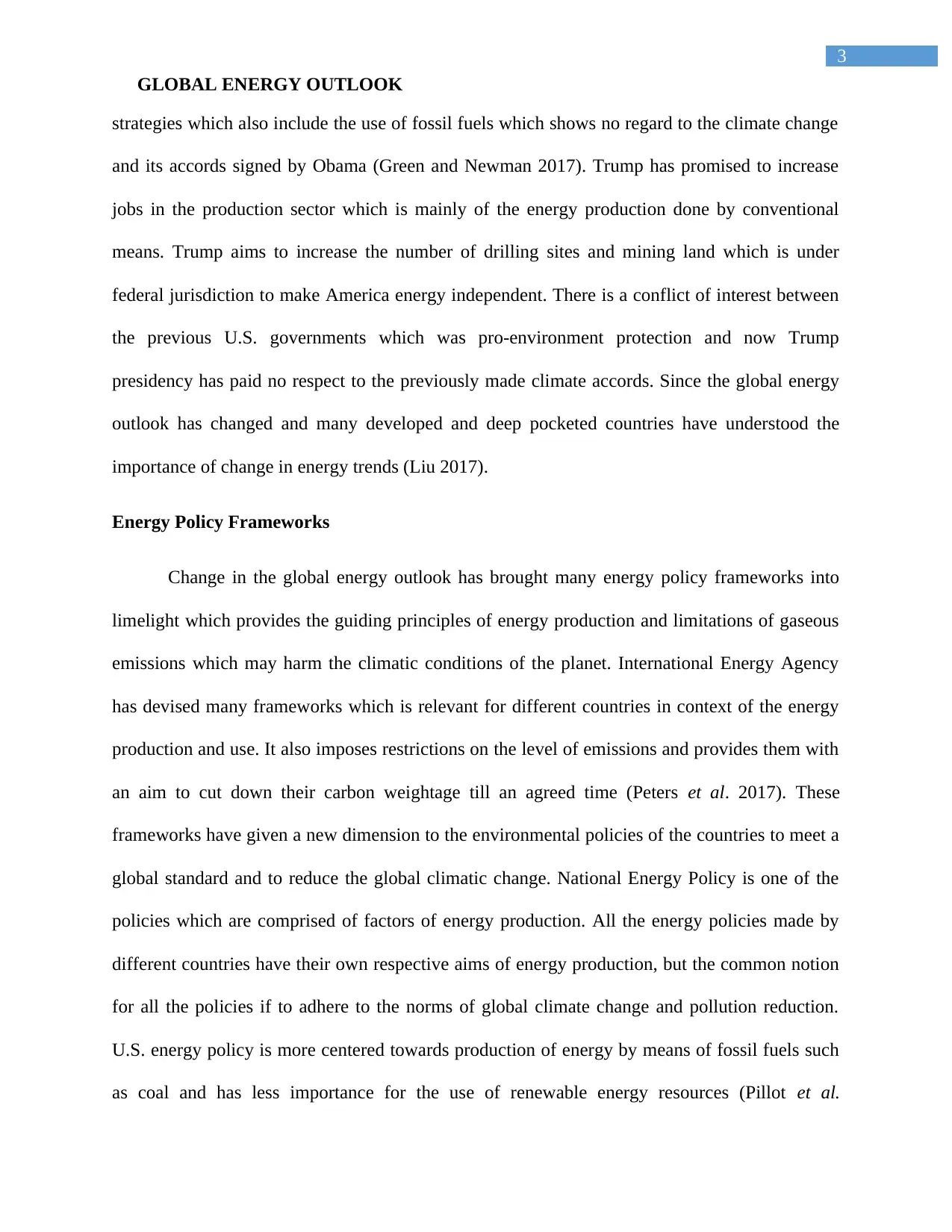
3
GLOBAL ENERGY OUTLOOK
strategies which also include the use of fossil fuels which shows no regard to the climate change
and its accords signed by Obama (Green and Newman 2017). Trump has promised to increase
jobs in the production sector which is mainly of the energy production done by conventional
means. Trump aims to increase the number of drilling sites and mining land which is under
federal jurisdiction to make America energy independent. There is a conflict of interest between
the previous U.S. governments which was pro-environment protection and now Trump
presidency has paid no respect to the previously made climate accords. Since the global energy
outlook has changed and many developed and deep pocketed countries have understood the
importance of change in energy trends (Liu 2017).
Energy Policy Frameworks
Change in the global energy outlook has brought many energy policy frameworks into
limelight which provides the guiding principles of energy production and limitations of gaseous
emissions which may harm the climatic conditions of the planet. International Energy Agency
has devised many frameworks which is relevant for different countries in context of the energy
production and use. It also imposes restrictions on the level of emissions and provides them with
an aim to cut down their carbon weightage till an agreed time (Peters et al. 2017). These
frameworks have given a new dimension to the environmental policies of the countries to meet a
global standard and to reduce the global climatic change. National Energy Policy is one of the
policies which are comprised of factors of energy production. All the energy policies made by
different countries have their own respective aims of energy production, but the common notion
for all the policies if to adhere to the norms of global climate change and pollution reduction.
U.S. energy policy is more centered towards production of energy by means of fossil fuels such
as coal and has less importance for the use of renewable energy resources (Pillot et al.
GLOBAL ENERGY OUTLOOK
strategies which also include the use of fossil fuels which shows no regard to the climate change
and its accords signed by Obama (Green and Newman 2017). Trump has promised to increase
jobs in the production sector which is mainly of the energy production done by conventional
means. Trump aims to increase the number of drilling sites and mining land which is under
federal jurisdiction to make America energy independent. There is a conflict of interest between
the previous U.S. governments which was pro-environment protection and now Trump
presidency has paid no respect to the previously made climate accords. Since the global energy
outlook has changed and many developed and deep pocketed countries have understood the
importance of change in energy trends (Liu 2017).
Energy Policy Frameworks
Change in the global energy outlook has brought many energy policy frameworks into
limelight which provides the guiding principles of energy production and limitations of gaseous
emissions which may harm the climatic conditions of the planet. International Energy Agency
has devised many frameworks which is relevant for different countries in context of the energy
production and use. It also imposes restrictions on the level of emissions and provides them with
an aim to cut down their carbon weightage till an agreed time (Peters et al. 2017). These
frameworks have given a new dimension to the environmental policies of the countries to meet a
global standard and to reduce the global climatic change. National Energy Policy is one of the
policies which are comprised of factors of energy production. All the energy policies made by
different countries have their own respective aims of energy production, but the common notion
for all the policies if to adhere to the norms of global climate change and pollution reduction.
U.S. energy policy is more centered towards production of energy by means of fossil fuels such
as coal and has less importance for the use of renewable energy resources (Pillot et al.
Paraphrase This Document
Need a fresh take? Get an instant paraphrase of this document with our AI Paraphraser
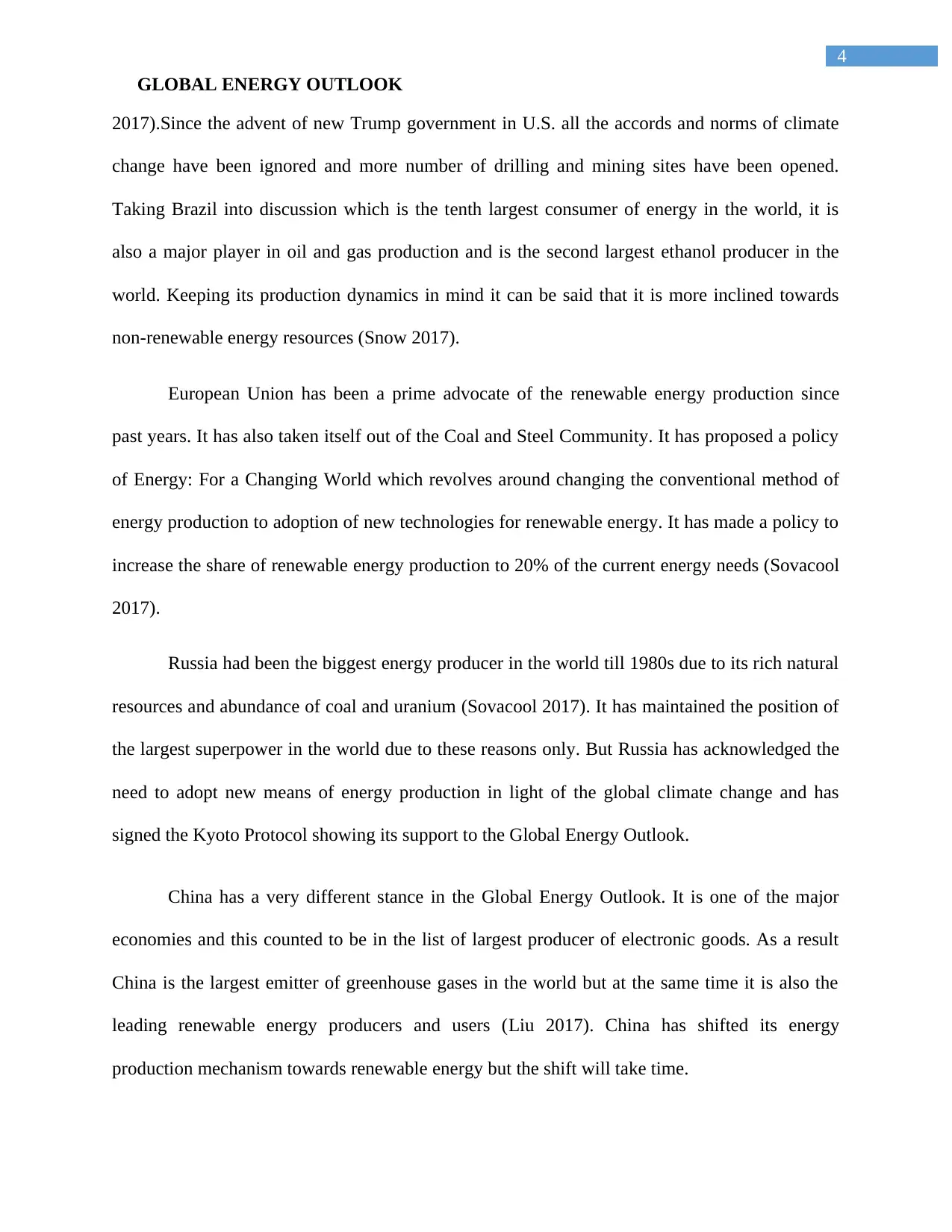
4
GLOBAL ENERGY OUTLOOK
2017).Since the advent of new Trump government in U.S. all the accords and norms of climate
change have been ignored and more number of drilling and mining sites have been opened.
Taking Brazil into discussion which is the tenth largest consumer of energy in the world, it is
also a major player in oil and gas production and is the second largest ethanol producer in the
world. Keeping its production dynamics in mind it can be said that it is more inclined towards
non-renewable energy resources (Snow 2017).
European Union has been a prime advocate of the renewable energy production since
past years. It has also taken itself out of the Coal and Steel Community. It has proposed a policy
of Energy: For a Changing World which revolves around changing the conventional method of
energy production to adoption of new technologies for renewable energy. It has made a policy to
increase the share of renewable energy production to 20% of the current energy needs (Sovacool
2017).
Russia had been the biggest energy producer in the world till 1980s due to its rich natural
resources and abundance of coal and uranium (Sovacool 2017). It has maintained the position of
the largest superpower in the world due to these reasons only. But Russia has acknowledged the
need to adopt new means of energy production in light of the global climate change and has
signed the Kyoto Protocol showing its support to the Global Energy Outlook.
China has a very different stance in the Global Energy Outlook. It is one of the major
economies and this counted to be in the list of largest producer of electronic goods. As a result
China is the largest emitter of greenhouse gases in the world but at the same time it is also the
leading renewable energy producers and users (Liu 2017). China has shifted its energy
production mechanism towards renewable energy but the shift will take time.
GLOBAL ENERGY OUTLOOK
2017).Since the advent of new Trump government in U.S. all the accords and norms of climate
change have been ignored and more number of drilling and mining sites have been opened.
Taking Brazil into discussion which is the tenth largest consumer of energy in the world, it is
also a major player in oil and gas production and is the second largest ethanol producer in the
world. Keeping its production dynamics in mind it can be said that it is more inclined towards
non-renewable energy resources (Snow 2017).
European Union has been a prime advocate of the renewable energy production since
past years. It has also taken itself out of the Coal and Steel Community. It has proposed a policy
of Energy: For a Changing World which revolves around changing the conventional method of
energy production to adoption of new technologies for renewable energy. It has made a policy to
increase the share of renewable energy production to 20% of the current energy needs (Sovacool
2017).
Russia had been the biggest energy producer in the world till 1980s due to its rich natural
resources and abundance of coal and uranium (Sovacool 2017). It has maintained the position of
the largest superpower in the world due to these reasons only. But Russia has acknowledged the
need to adopt new means of energy production in light of the global climate change and has
signed the Kyoto Protocol showing its support to the Global Energy Outlook.
China has a very different stance in the Global Energy Outlook. It is one of the major
economies and this counted to be in the list of largest producer of electronic goods. As a result
China is the largest emitter of greenhouse gases in the world but at the same time it is also the
leading renewable energy producers and users (Liu 2017). China has shifted its energy
production mechanism towards renewable energy but the shift will take time.
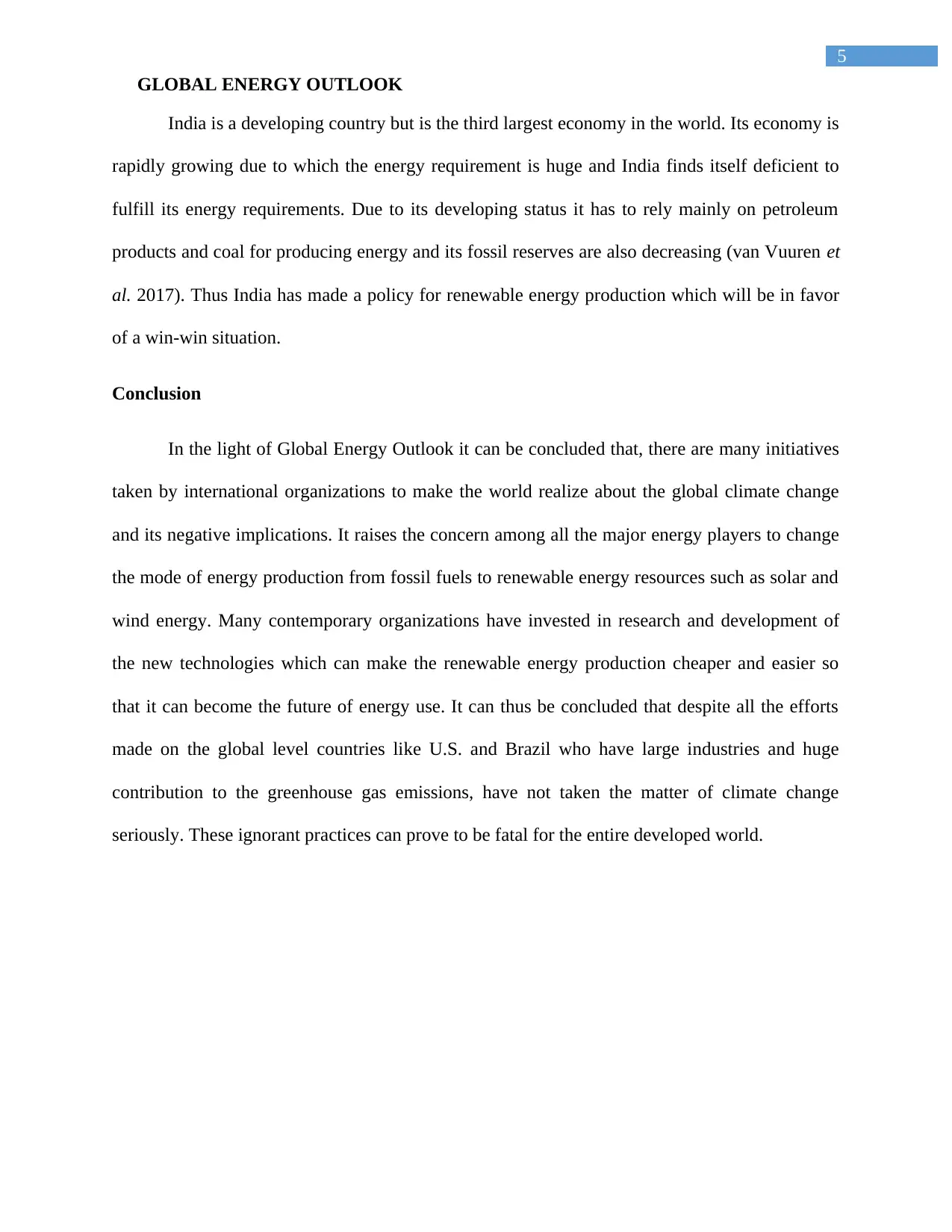
5
GLOBAL ENERGY OUTLOOK
India is a developing country but is the third largest economy in the world. Its economy is
rapidly growing due to which the energy requirement is huge and India finds itself deficient to
fulfill its energy requirements. Due to its developing status it has to rely mainly on petroleum
products and coal for producing energy and its fossil reserves are also decreasing (van Vuuren et
al. 2017). Thus India has made a policy for renewable energy production which will be in favor
of a win-win situation.
Conclusion
In the light of Global Energy Outlook it can be concluded that, there are many initiatives
taken by international organizations to make the world realize about the global climate change
and its negative implications. It raises the concern among all the major energy players to change
the mode of energy production from fossil fuels to renewable energy resources such as solar and
wind energy. Many contemporary organizations have invested in research and development of
the new technologies which can make the renewable energy production cheaper and easier so
that it can become the future of energy use. It can thus be concluded that despite all the efforts
made on the global level countries like U.S. and Brazil who have large industries and huge
contribution to the greenhouse gas emissions, have not taken the matter of climate change
seriously. These ignorant practices can prove to be fatal for the entire developed world.
GLOBAL ENERGY OUTLOOK
India is a developing country but is the third largest economy in the world. Its economy is
rapidly growing due to which the energy requirement is huge and India finds itself deficient to
fulfill its energy requirements. Due to its developing status it has to rely mainly on petroleum
products and coal for producing energy and its fossil reserves are also decreasing (van Vuuren et
al. 2017). Thus India has made a policy for renewable energy production which will be in favor
of a win-win situation.
Conclusion
In the light of Global Energy Outlook it can be concluded that, there are many initiatives
taken by international organizations to make the world realize about the global climate change
and its negative implications. It raises the concern among all the major energy players to change
the mode of energy production from fossil fuels to renewable energy resources such as solar and
wind energy. Many contemporary organizations have invested in research and development of
the new technologies which can make the renewable energy production cheaper and easier so
that it can become the future of energy use. It can thus be concluded that despite all the efforts
made on the global level countries like U.S. and Brazil who have large industries and huge
contribution to the greenhouse gas emissions, have not taken the matter of climate change
seriously. These ignorant practices can prove to be fatal for the entire developed world.
⊘ This is a preview!⊘
Do you want full access?
Subscribe today to unlock all pages.

Trusted by 1+ million students worldwide
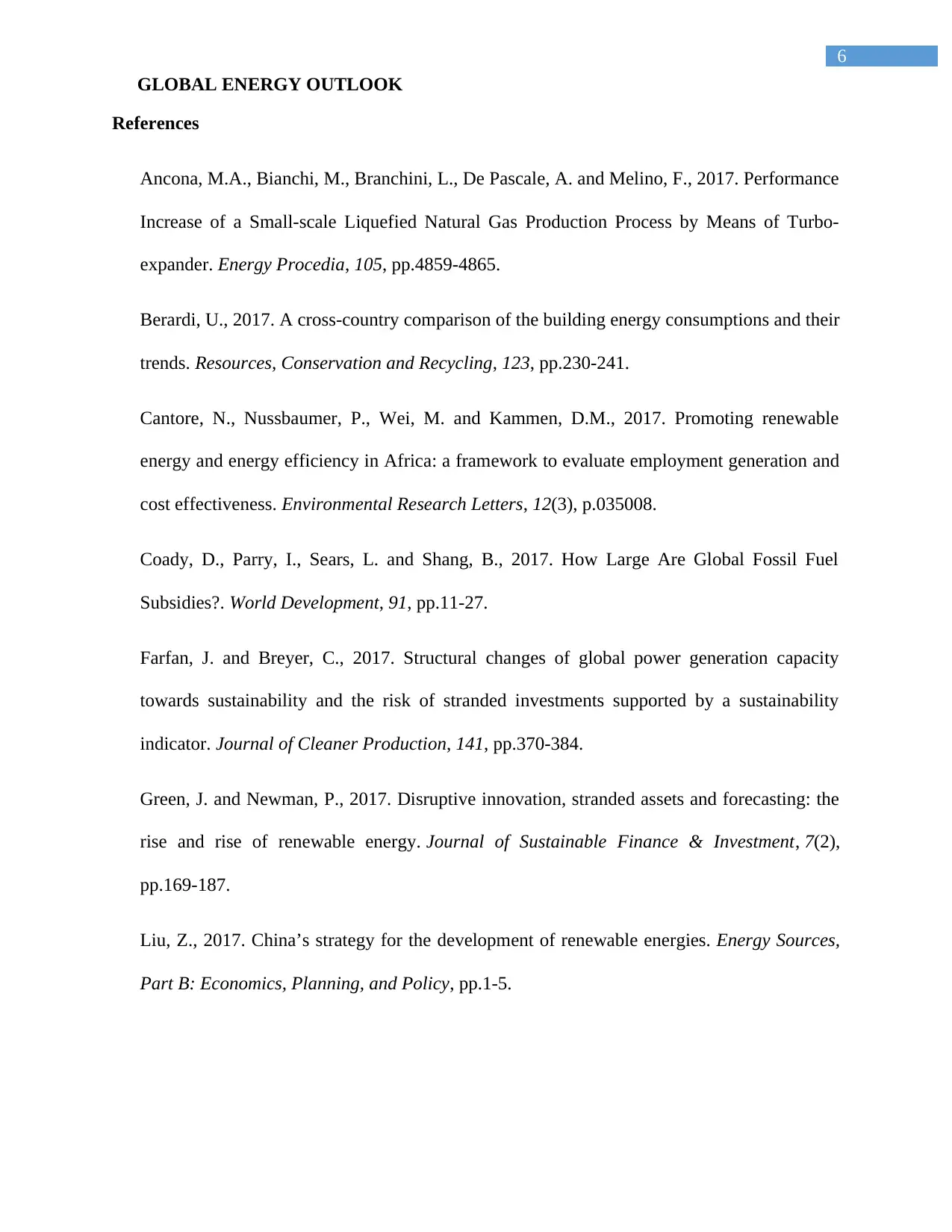
6
GLOBAL ENERGY OUTLOOK
References
Ancona, M.A., Bianchi, M., Branchini, L., De Pascale, A. and Melino, F., 2017. Performance
Increase of a Small-scale Liquefied Natural Gas Production Process by Means of Turbo-
expander. Energy Procedia, 105, pp.4859-4865.
Berardi, U., 2017. A cross-country comparison of the building energy consumptions and their
trends. Resources, Conservation and Recycling, 123, pp.230-241.
Cantore, N., Nussbaumer, P., Wei, M. and Kammen, D.M., 2017. Promoting renewable
energy and energy efficiency in Africa: a framework to evaluate employment generation and
cost effectiveness. Environmental Research Letters, 12(3), p.035008.
Coady, D., Parry, I., Sears, L. and Shang, B., 2017. How Large Are Global Fossil Fuel
Subsidies?. World Development, 91, pp.11-27.
Farfan, J. and Breyer, C., 2017. Structural changes of global power generation capacity
towards sustainability and the risk of stranded investments supported by a sustainability
indicator. Journal of Cleaner Production, 141, pp.370-384.
Green, J. and Newman, P., 2017. Disruptive innovation, stranded assets and forecasting: the
rise and rise of renewable energy. Journal of Sustainable Finance & Investment, 7(2),
pp.169-187.
Liu, Z., 2017. China’s strategy for the development of renewable energies. Energy Sources,
Part B: Economics, Planning, and Policy, pp.1-5.
GLOBAL ENERGY OUTLOOK
References
Ancona, M.A., Bianchi, M., Branchini, L., De Pascale, A. and Melino, F., 2017. Performance
Increase of a Small-scale Liquefied Natural Gas Production Process by Means of Turbo-
expander. Energy Procedia, 105, pp.4859-4865.
Berardi, U., 2017. A cross-country comparison of the building energy consumptions and their
trends. Resources, Conservation and Recycling, 123, pp.230-241.
Cantore, N., Nussbaumer, P., Wei, M. and Kammen, D.M., 2017. Promoting renewable
energy and energy efficiency in Africa: a framework to evaluate employment generation and
cost effectiveness. Environmental Research Letters, 12(3), p.035008.
Coady, D., Parry, I., Sears, L. and Shang, B., 2017. How Large Are Global Fossil Fuel
Subsidies?. World Development, 91, pp.11-27.
Farfan, J. and Breyer, C., 2017. Structural changes of global power generation capacity
towards sustainability and the risk of stranded investments supported by a sustainability
indicator. Journal of Cleaner Production, 141, pp.370-384.
Green, J. and Newman, P., 2017. Disruptive innovation, stranded assets and forecasting: the
rise and rise of renewable energy. Journal of Sustainable Finance & Investment, 7(2),
pp.169-187.
Liu, Z., 2017. China’s strategy for the development of renewable energies. Energy Sources,
Part B: Economics, Planning, and Policy, pp.1-5.
Paraphrase This Document
Need a fresh take? Get an instant paraphrase of this document with our AI Paraphraser
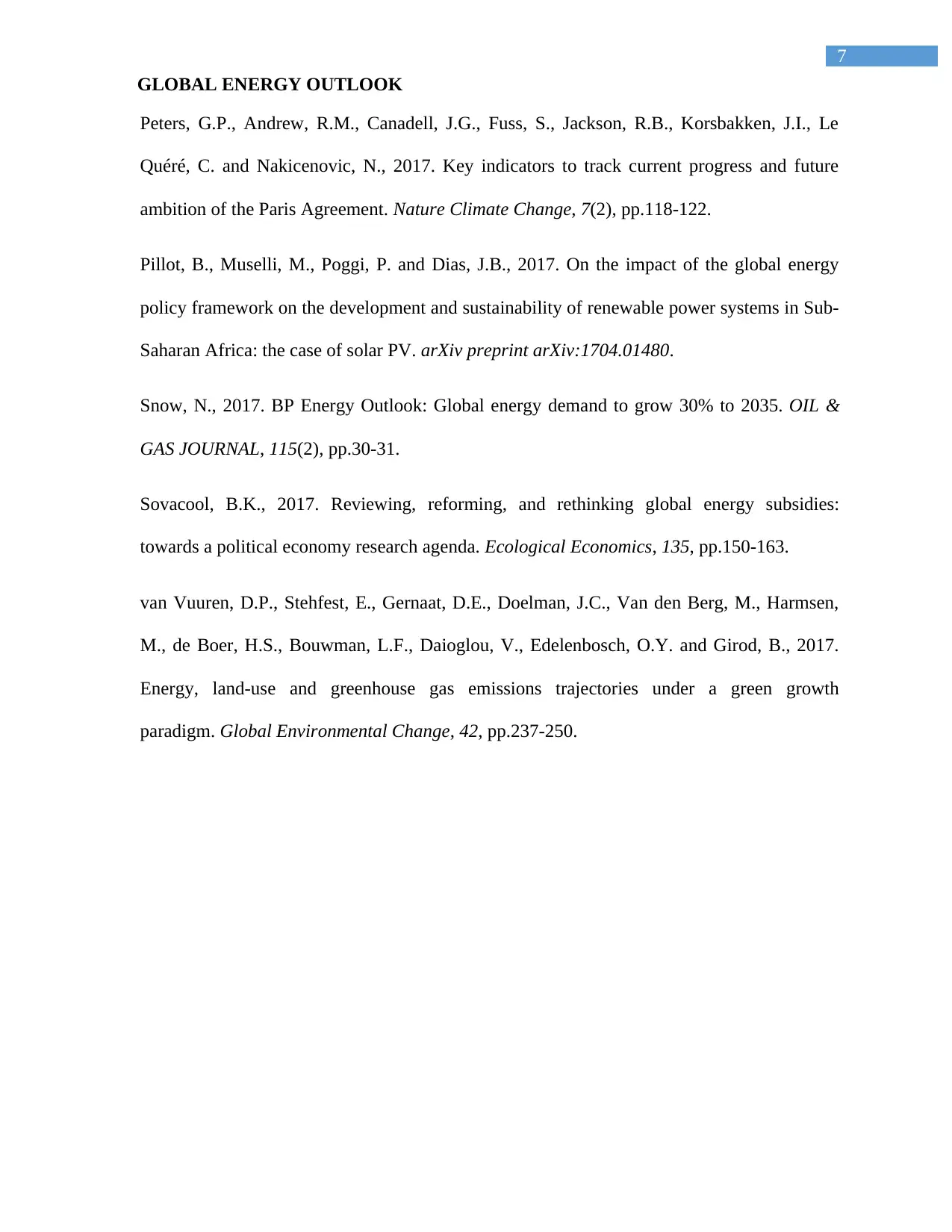
7
GLOBAL ENERGY OUTLOOK
Peters, G.P., Andrew, R.M., Canadell, J.G., Fuss, S., Jackson, R.B., Korsbakken, J.I., Le
Quéré, C. and Nakicenovic, N., 2017. Key indicators to track current progress and future
ambition of the Paris Agreement. Nature Climate Change, 7(2), pp.118-122.
Pillot, B., Muselli, M., Poggi, P. and Dias, J.B., 2017. On the impact of the global energy
policy framework on the development and sustainability of renewable power systems in Sub-
Saharan Africa: the case of solar PV. arXiv preprint arXiv:1704.01480.
Snow, N., 2017. BP Energy Outlook: Global energy demand to grow 30% to 2035. OIL &
GAS JOURNAL, 115(2), pp.30-31.
Sovacool, B.K., 2017. Reviewing, reforming, and rethinking global energy subsidies:
towards a political economy research agenda. Ecological Economics, 135, pp.150-163.
van Vuuren, D.P., Stehfest, E., Gernaat, D.E., Doelman, J.C., Van den Berg, M., Harmsen,
M., de Boer, H.S., Bouwman, L.F., Daioglou, V., Edelenbosch, O.Y. and Girod, B., 2017.
Energy, land-use and greenhouse gas emissions trajectories under a green growth
paradigm. Global Environmental Change, 42, pp.237-250.
GLOBAL ENERGY OUTLOOK
Peters, G.P., Andrew, R.M., Canadell, J.G., Fuss, S., Jackson, R.B., Korsbakken, J.I., Le
Quéré, C. and Nakicenovic, N., 2017. Key indicators to track current progress and future
ambition of the Paris Agreement. Nature Climate Change, 7(2), pp.118-122.
Pillot, B., Muselli, M., Poggi, P. and Dias, J.B., 2017. On the impact of the global energy
policy framework on the development and sustainability of renewable power systems in Sub-
Saharan Africa: the case of solar PV. arXiv preprint arXiv:1704.01480.
Snow, N., 2017. BP Energy Outlook: Global energy demand to grow 30% to 2035. OIL &
GAS JOURNAL, 115(2), pp.30-31.
Sovacool, B.K., 2017. Reviewing, reforming, and rethinking global energy subsidies:
towards a political economy research agenda. Ecological Economics, 135, pp.150-163.
van Vuuren, D.P., Stehfest, E., Gernaat, D.E., Doelman, J.C., Van den Berg, M., Harmsen,
M., de Boer, H.S., Bouwman, L.F., Daioglou, V., Edelenbosch, O.Y. and Girod, B., 2017.
Energy, land-use and greenhouse gas emissions trajectories under a green growth
paradigm. Global Environmental Change, 42, pp.237-250.
1 out of 8
Related Documents
Your All-in-One AI-Powered Toolkit for Academic Success.
+13062052269
info@desklib.com
Available 24*7 on WhatsApp / Email
![[object Object]](/_next/static/media/star-bottom.7253800d.svg)
Unlock your academic potential
Copyright © 2020–2025 A2Z Services. All Rights Reserved. Developed and managed by ZUCOL.





